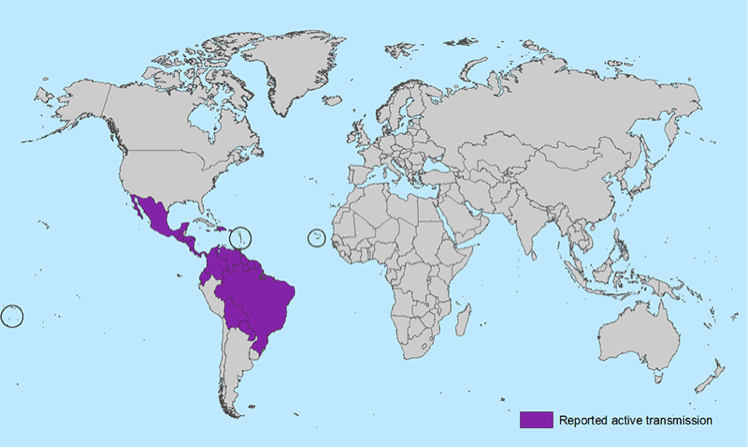Pregnant women and Zika exposure: An update from CDC at an ad-hoc SMFM meeting
A new update on Zika virus and pregnant women was shared during an ad-hoc session at the 36th SMFM Pregnancy Meeting in Atlanta, Georgia.

Conference room filled to capacity during ad-hoc session at the Society for Maternal-Fetal Medicine (SMFM) Annual Meeting in Atlanta, Georgia. (Photo Credit: Yalda Afshar, MD, PhD)An ad-hoc session was held at the Society for Maternal-Fetal Medicine (SMFM) 36th Annual Pregnancy Meeting to share knowledge and discuss clinical best practices for optimizing maternal and perinatal health in the face of the recent Zika virusepidemic. Dr Laura Riley, SMFM’s immediate past president, Director of Labor and Delivery at the Massachusetts General Hospital, and an obstetrical infectious diseases expert, organized a panel of leaders, including William Callaghan, MD, MPH, Chief of the Maternal and Infant Health Branch of CDC’s Division of Reproductive Health; Brenna Hughes, MD, MSCR, Associate Professor at Alpert Medical School of Brown University; and R Phillips Heine, MD, Professor and Division Chief of MFM at Duke University. This panel was tasked with relaying the released interim guidelines on the management of pregnant women with possible Zika virus exposure.
More: Diagnosis and antenatal management of CMV infection
Zika is a mosquito-borne single-stranded RNA Flavivirus, related to dengue virus. According to the CDC, only 1 in 5 people infected with Zika virus will become symptomatic. Characteristic clinical findings are an acute onset of fever with maculopapular rash, arthralgias, or conjunctivitis, usually within 1-2 weeks of infection.1 Other reported symptoms include a headache or myalgias. The illness is usually mild, with symptoms lasting for several days to a week. The actual Zika viral infection rate, incidence of maternal-fetal transmission, immune response, and any causal relationship to fetal microcephaly, abnormal brain development, or other adverse pregnancy outcome, are not currently known. Moreover, the CDC is uncertain on the sensitivity and specificity of currently available serologic testing (IgM, no IgG testing available). Current countries with reported active Zika virus transmission are shown in Figure 1, although CDC cautions that this map is routinely updated and should be rechecked frequently.
FIGURE 1: Countries with active Zika virus transmission [Source: CDC.gov]
Current guidelines call for at least baseline sonographic screening for fetal anomalies in general and for head and brain development specifically for pregnant women with exposure in Zika-endemic areas. Along with the potential need to discuss alternative differential diagnoses to explain any reported symptoms or findings, it is prudent and recommended to refer patients with concerns about Zika exposure or Zika-associated fetal issues to an MFM subspecialist with specific knowledge in this area whenever feasible. Subspecialists will then work directly with local and state health departments to coordinate testing and interpretation of results. A listing of state and territorial health departments can be found at http://www.cdc.gov/mmwr/international/relres.html. Zika testing currently is being performed almost exclusively at the CDC, but with the approval of a local health authority, many states are actively developing programs for screening and testing exposed pregnant women on a more local level.
Appropriate clinical scenarios requiring serum testing are listed below in the case studies. When sent, Zika serology IgM testing will be the most commonly run assay, with results reported as a titer, interpreted as “likely positive,” “inconclusive,” or “likely negative.” If a patient has been symptomatic in the preceding week (and only then), Zika RNA testing by reverse-transcriptase PCR (RT-PCR) will be performed. This emphasizes the importance of taking and providing a detailed travel and symptom history to the lab performing the testing. The sensitivity of the IgM assay is currently unknown and is being evaluated. This serum sample should also be tested for other common flaviviruses endemic to the area, such as dengue and chikungunya, but these tests must be ordered separately by the provider through commercial labs. A history should be obtained for prior exposure (vaccination or infection) to dengue, yellow fever, Japanese encephalitis or West Nile viruses, as these antibodies may cross-react with Zika testing. A positive Zika virus IgM should have a confirmatory neutralizing antibody titer ≥4-fold higher than dengue virus-neutralizing antibody titers in serum by plaque-reduction neutralization testing. Testing would be considered inconclusive if Zika virus-neutralizing antibody titers are < 4-fold higher than dengue virus-neutralizing antibody titers.
NEXT: Avoiding mosquito bites and looking at cases
Physicians should maintain a log of all patients who have traveled to Zika-endemic regions, as there may be a need for reconsultation with these patients when our knowledge about the virus advances and CDC recommendations are updated.
Also from SMFM: How routine should screening for preterm birth be in at-risk nulliparas?
Providers must reinforce avoidance of travel to endemic regions for patients who are currently pregnant. When necessary, mosquito bite prevention is integral, including use of insect repellent, appropriate attire to shield extremities, and staying in places with windows, screen doors, or air conditioning. Environmental Protection Agency-registered insect repellents containing ingredients such as DEET, picaridin, and IR3535 are safe for use during pregnancy. Patients can also be directed to the CDC website for information on how to avoid mosquito bites: http://www.cdc.gov/features/stopmosquitoes/.
Because of the concern about maternal-fetal transmission of Zika, screening protocols have been established, as illustrated by the case scenarios below.
Case #1: Asymptomatic women with a history of travel to an endemic area.
A pregnant woman presents to your office at 19 weeks with a history of travel to Mexico between 16+0 and 16+5-weeks. She has noted mosquito bites but no illness. How would you manage this patient?
In an asymptomatic patient with a history of travel to an endemic area, serum IgM assay is now recommended between 2 and 12 weeks after exposure. If the IgM result is positive or inconclusive, serial fetal ultrasounds to screen for microcephaly and intracranial calcifications should be performed. It is important for physicians to be aware that fetal ultrasounds may not detect microcephaly or intracranial calcifications until the late second or early third trimester of pregnancy. If there are markers concerning for fetal infection, amniocentesis with RT-PCR testing for Zika virus RNA should also be considered after 15 weeks’ gestation. The sensitivity and specificity of RT-PCR testing on amniotic fluid and the maternal-fetal transmission risks from an invasive procedure are unknown at this time.
Even if the IgM result is negative, a baseline screening ultrasound should be performed, but at this time, multiple serial scans are not believed to have a role. If microcephaly or intracranial calcifications are present, amniocentesis with RT-PCR testing and retesting for IgM assay should be considered. If the patient is negative for both serologic testing and no ultrasound results in no findings, the patient can resume routine prenatal care.
For more information including treatment algorithms, visit: http://www.cdc.gov/mmwr/volumes/65/wr/mm6503e3.htm
Case #2: Symptomatic women with a history of travel to an endemic area.
A pregnant woman presents to your office at 26 weeks with a history of travel to Colombia on January 12th - 19th. She has noted bites, fever, and a rash. How would you manage this patient?
Clinical illness consistent with Zika virus disease is defined as 2 or more of the following signs or symptoms: acute onset of fever, maculopapular rash, arthralgia, or conjunctivitis. If your patient has a history of travel to an area with ongoing Zika virus transmission and presents with signs of an acute infection within 2 weeks of travel, serologic testing for Zika virus IgM is recommended between 2 and 12 weeks after exposure, along with fetal ultrasound to detect microcephaly or intracranial calcifications. If the serologic testing is positive or inconclusive, or if there are ultrasound findings consistent with Zika virus infection, amniocentesis with RT-PCR testing for Zika virus should be considered.
Case #3: Asymptomatic patients living in areas with endemic Zika transmission.
A pregnant woman who was living in Puerto Rico presents to your office at 32 weeks. You perform an ultrasound, which is normal. How would you manage this patient?
Pregnant women who reside in areas that are endemic for Zika virus and are asymptomatic during clinical evaluation should be offered screening for Zika virus with serologic testing for IgM antibodies at the initiation of prenatal care and again mid-second trimester. In addition, a fetal ultrasound to detect microcephaly and intracranial calcifications should be performed, ideally between 18 and 20 weeks. If these evaluations are negative, the patient should resume routine prenatal care. An additional fetal ultrasound can be considered later in the pregnancy, based on clinical suspicion.
If serologic testing is positive or inconclusive, amniocentesis with RT-PCR testing for Zika virus RNA should be considered after 15 weeks’ gestation. Serial fetal ultrasounds should also be considered to screen for microcephaly and microcalcifications. Whenever these ultrasound abnormalities are present, amniocentesis with PCR testing and retesting for IgM assay should be considered, no more than every 4 to 6 weeks if baseline was normal.
Related: What you need to know about the Zika virus
If the patient develops symptoms consistent with Zika virus during her pregnancy, she should be retested for it, even if a previous test was negative. If the symptom onset was within 7 days, amniocentesis with RT-PCR is the preferred test. However, given the possibility of a false-negative result, serologic screening for IgM antibodies should still be performed concurrently. If these evaluations are negative, the patient should resume routine prenatal care. An additional fetal ultrasound can be considered later in the pregnancy based on clinical suspicion.
NEXT: What about alternate modes of transmission?
Regarding alternatives methods of potential transmission:
- Recent case reports and confirmation of Zika virus in semen samples raise the concern for potential for sexual transmission of Zika virus. The CDC recommends that pregnant women whose male partners have or are at risk for Zika virus infection consider using barrier contraception (condoms) or abstaining from sexual intercourse.
- There are currently no recommendations for abstinence from breastfeeding in women with potential exposure.
Next: Key points about 4 perinatal infections
Summary
- Every patient with a travel history to endemic areas within 2 to 12 weeks should get serum serological screening for Zika virus, regardless of presence of Zika symptoms. Follow the above algorithms for ultrasound surveillance.
- Amniocentesis for RT-PCR for Zika virus should be considered for all women who have positive IgM serum tests.
- If microcalcifications or microcephaly are present on fetal ultrasound, the patient should have serologic testing, even if previous tests were negative. Amniocentesis for Zika virus RT-PCR testing should also be considered.
- Because Zika is an emerging disease, we recommend that providers and patients continue to stay up to date by frequently checking the CDC website (http://www.cdc.gov/zika), as information is updated as it becomes available.
REFERENCES
1. Petersen EE, Staples JE, Meaney-Delman, D, et al. Interim Guidelines for Pregnant Women During a Zika Virus Outbreak - United States, 2016. MMWR Morb Mortal Wkly Rep 2016;65:30–33. DOI: http://dx.doi.org/10.15585/mmwr.mm6502e1
2. Oster AM, Brooks JT, Stryker JE, et al. Interim Guidelines for Prevention of Sexual Transmission of Zika Virus - United States, 2016. MMWR Morb Mortal Wkly Rep 2016;65(Early Release):1–2. DOI: http://dx.doi.org/10.15585/mmwr.mm6505e1er
A Legacy of Excellence: Reflecting on the Final Print Edition of Contemporary OB/GYN
April 25th 2025Marking the end of an era and the beginning of a new chapter, the final print edition of Contemporary OB/GYN celebrates over 50 years of evidence-based guidance and unwavering support for clinicians.
Read More

